The Silent Crisis in SAP Governance
Picture this scenario: Your company runs critical operations on SAP, managing financials, HR, supply chain, and more. Everything seems to be working fine until your auditors deliver troubling news. Despite investing heavily in SAP GRC 10.x for years, your compliance gaps are widening, not shrinking. Manual processes are overwhelming your team, and SAP is nudging you toward a costly upgrade to version 12.x or their cloud solution.
Sound familiar? You’re not alone.
For thousands of organizations worldwide, SAP systems represent the digital backbone of their operations. Yet many are discovering that SAP’s native governance solutions, particularly aging GRC 10.x implementations, are creating more problems than they solve in today’s complex IT environments.
The most troubling part? SAP’s maintenance strategy is forcing organizations into a difficult choice: invest in expensive upgrades or accept diminishing support with increasing maintenance fees. As noted in SAP’s own community, “extended maintenance has additional charges and customer-specific maintenance has limited support.” But there’s a third option that many companies are now pursuing, with remarkable results.
Why Traditional SAP Governance Is Breaking Down
Before exploring alternatives, let’s understand why the traditional approach is failing:
The Siloed Security Problem: SAP GRC excels at governing SAP applications but leaves your non-SAP applications in governance darkness. In today’s hybrid environments where employees access dozens of systems, this creates dangerous blind spots.
The Spreadsheet Nightmare: When systems can’t be managed through SAP GRC, teams resort to manual, spreadsheet-based workflows. A SailPoint study of over 300 security and IT professionals found this approach creates significant compliance gaps while overburdening already-strained teams.
The Automation Gap: Limited automation increases human error and compliance risks. When managers face reviewing thousands of access items each quarter, “approve all” becomes the dangerous norm.
And that’s just the beginning of the challenges. The real question is: what can be done about it?
Enter SailPoint: A Complete Replacement Strategy
Rather than simply integrating with SAP GRC, forward-thinking organizations are completely replacing their aging GRC implementations with SailPoint Identity Security Cloud (ISC). This approach delivers unified governance across all applications while eliminating the costs of maintaining end-of-life software.
But how does this work in practice? Let’s look at what makes this replacement strategy effective:
Unified Governance Across Everything: Unlike SAP GRC, which focuses primarily on SAP applications, SailPoint provides centralized control over user access across your entire application landscape, SAP S/4HANA, Salesforce, Active Directory, and hundreds of other systems, all from one platform. SailPoint’s connectivity solutions are specifically designed to manage and secure access to both SAP and non-SAP applications.
Native Risk Analysis: SailPoint includes a robust risk engine capable of performing Segregation of Duties checks across both SAP and non-SAP systems. This eliminates the need to retain SAP GRC for risk management while expanding risk visibility across the enterprise. According to SailPoint documentation, their comprehensive risk analysis capabilities address IT governance controls around logical access and SoD conflicts.

Automation That Actually Works: By automating critical processes like user provisioning, access reviews, and real-time SoD checks, SailPoint minimizes manual errors and closes compliance gaps. This isn’t just incremental improvement, it’s transformational.
Let’s see what this looks like in real-world scenarios.
Success Stories: Breaking Free from SAP GRC
Organizations replacing SAP GRC with SailPoint are seeing remarkable results:
Vodafone Turkey reduced user provisioning time from 6 hours to under 10 minutes while eliminating spreadsheet-based compliance processes. According to SailPoint’s compliance report, this delivered stronger audit capabilities and significant compliance effort reduction.
A global NYSE-listed packaging company unified governance across multiple SAP systems, standardized processes, and simplified SOX compliance, all while avoiding a costly SAP GRC upgrade. As detailed in a case study, they implemented SailPoint Identity Security Cloud with Access Risk Management as a cloud-based solution.
Aviva, a major UK insurer, implemented SailPoint across 5 countries in under 6 months, significantly lowering IT compliance costs and reducing audit overhead. According to SailPoint’s customer success documentation, this implementation centralized access certifications and SOD policy enforcement that previously required manual, siloed processes.
These results aren’t just impressive, they’re indicative of a fundamental shift in how organizations approach governance. But the question remains: how can your organization make this transition successfully?

The Migration Path: From SAP GRC to SailPoint
The journey from SAP GRC to complete SailPoint replacement involves several key phases, which we’ll explore in more detail:
- Assessment and Planning
Start by inventorying your GRC rules, SoD matrices, and role catalogs. Document your current segregation of duties definitions and map GRC functions to SailPoint features. This foundation ensures nothing gets lost in translation. - Implementation Approach
Deploy SailPoint ISC as your centralized identity governance platform, connecting directly to SAP systems using official connectors. Migrate your SAP GRC risk rules to SailPoint’s native risk analysis engine and implement access request workflows that embed SoD checking. - Governance Transition
Set up access certification campaigns in SailPoint to replace SAP GRC reviews, enable continuous compliance monitoring, and implement automated provisioning with built-in SoD controls. Once SailPoint covers all critical functions, you can decommission SAP GRC entirely.
This approach allows you to not only replace SAP GRC but to enhance your governance capabilities across the entire enterprise.
Key Capabilities That Make Replacement Possible
SailPoint offers several advanced capabilities that enable complete SAP GRC replacement:
Direct SAP Connectivity: SailPoint connects directly to SAP systems using native interfaces (RFC/BAPI or REST APIs) to provision accounts, assign roles, and read identity data without requiring GRC as middleware. SailPoint’s SAP integration helps enterprises address complex identity security challenges across cloud, on-premises, and hybrid environments.
Complete Risk Analysis: By migrating all SAP GRC risk rules to SailPoint’s Access Risk Management module, organizations gain a unified risk framework spanning both SAP and non-SAP applications. For effective Segregation of Duties, SailPoint’s best practices ensure no single individual is responsible for an entire transaction.
Automated Access Certification: SailPoint’s automated certification campaigns replace manual SAP GRC access reviews with business-friendly interfaces and closed-loop remediation workflows.
Emergency Access Management: SailPoint’s privileged access workflow replaces SAP GRC’s Firefighter functionality with more streamlined yet equally secure processes.
Each of these capabilities addresses a specific gap in traditional SAP governance, creating a more comprehensive and effective approach.
The Future of SAP Governance
As organizations continue their digital transformation journeys, siloed governance approaches become increasingly untenable. By extending SAP governance beyond SAP applications, automating manual processes, and enabling continuous compliance monitoring, SailPoint creates a governance framework that scales with your business, adapts to changing regulations, and supports rather than impedes transformation.
For organizations currently utilizing SAP GRC 10.x, SailPoint ISC offers a compelling alternative to costly upgrades. Instead of investing in maintaining end-of-life software, you can deploy a solution that delivers superior governance capabilities across your entire organization.
The question is no longer whether to modernize your SAP governance approach, but how quickly you can make the transition to a more unified, automated, and effective solution.
Is your organization ready to break free from the limitations of SAP GRC? The path to modern governance may be more accessible than you think.




